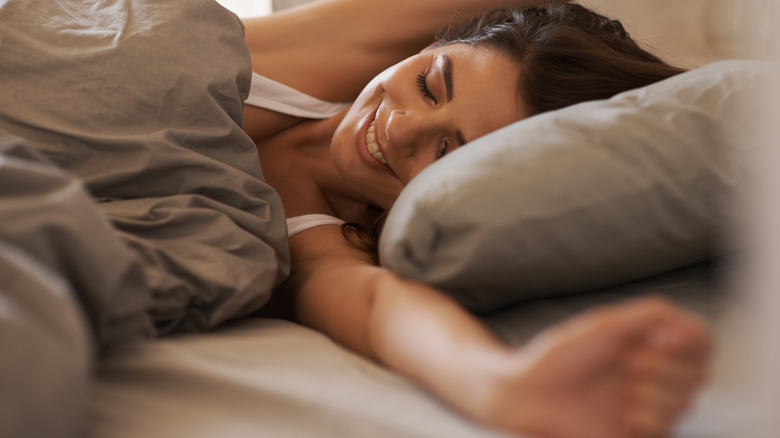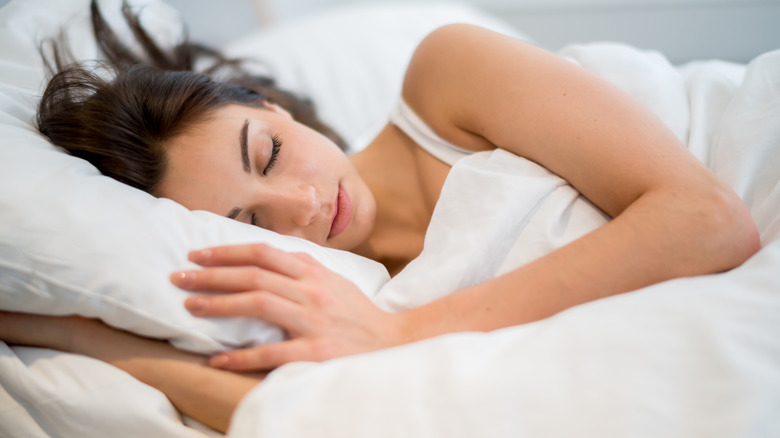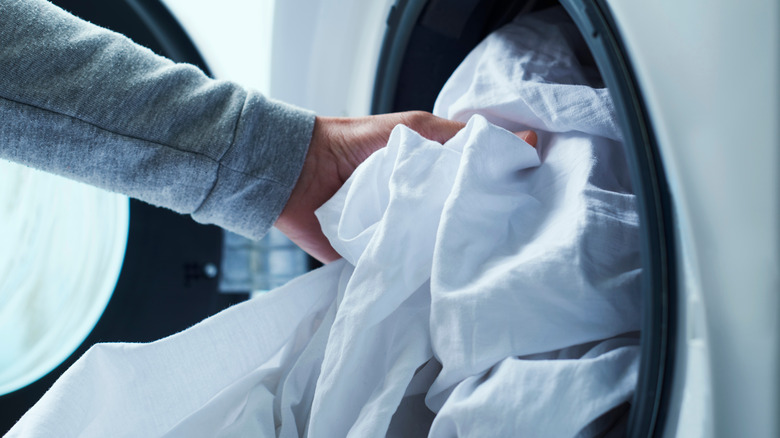The Bedsheet Color That Could Actually Free Your Skin Of Breakouts
If acne is a regular part of your life, you've probably done everything you can do to minimize breakouts. In addition to adopting a skincare routine that can benefit your skin, you may have heard that it's also a good idea to change your bedsheets and pillowcases often. According to New York City-based board-certified dermatologist, Joshua Zeichner (via Self), "Every night when you sleep, dirt and oil are transferred from your skin to your sheets. Especially if you also aren't washing your face regularly before bed, dirt and oil can build up in the fabrics of your pillowcases and sheets over time." This means that your bedding can basically be a breeding ground for acne triggers.
Did you know, however, that the color of your bedsheets could also influence your breakouts? According to board-certified dermatologist, Dr. Janet Prystowsky (via SheKnows), white is a good color simply because it reminds you to wash your sheets more often. No, the hue won't magically make your pimples disappear when you wake up the next morning — but white pillowcases would alert you of any stains, dirt, and grime in your bedding. As explained by Dr. Prystowsky, "It will keep you honest about your habits, whether you wear makeup to bed, eat in bed, wear outdoor clothing in bed, or forget to wash your sheets. Buying a set of white sheets may be the push you need to get your bed hygiene in order. That will definitely reflect positively on your hair and skin."
Bed linen hygiene for better skin
Breakouts can be triggered by many things in our lives — our lifestyle habits, diet, stress, hormonal changes, and sleeping habits are just a few of the factors.
When it comes to bedding, most dermatologists would reiterate that you should be choosing the right fabric in addition to paying attention to a skincare routine that involves salicylic acid or benzoyl peroxide. Hypoallergenic, lightweight, and breathable materials are what you should be going for, per Women's Wear Daily. This means silk, satin, bamboo, and cotton. But with cotton, you should also be paying attention to how often you wash the pillowcases, since it's more absorbent than the other materials.
According to board-certified and licensed family nurse practitioner specializing in facial aesthetics, Vanessa Coppola (via Women's Wear Daily), "When going the cotton route, I would recommend choosing a lightweight 100% cotton without added synthetic materials, which can cause heat-trapping against the skin. Typically the higher the thread count, the softer the pillow, which can help to reduce shearing forces against the skin." Coppola also recommended white bed linen to alert you of dirt buildup.
Getting a good night's sleep can also work wonders for your skin. And white is thought of as a calming and cooling color when it comes to sleep hygiene. Even if it won't miraculously banish breakouts, at the very least, clean and crisp white sheets might make you feel comforted and stress-free as you drift off to sleep.
How you wash your white bedsheets also matters
Most health experts recommend washing your bedding at least once a week — and your pillowcases more often than that. This is especially true if you have acne or if you are prone to going to bed without cleansing your face. You want to make sure that the surface you're lying on is as clean as it can be, given that you'll be spending seven or more hours on it each day. "Pillowcases harbor sweat, skin and hair oils, as well as, if you're a side or stomach sleeper, you're going to invariably drool a little bit in your sleep. So you have saliva there," shared dermatologist and skincare expert, Dr. Andrea Suarez on YouTube.
When washing your white bedsheets, the number one rule would be to separate them from other colors just so you don't end up with a Rachel Green situation like in the 1994 sitcom, "Friends". Once you've separated the laundry, wash your bedding in warm water and gentle detergent. As shared by board-certified dermatologist, Dr. Yoram Harth, per House Beautiful, the gentler the better — the last thing you want is to add another sneaky cause of breakouts to your list of worries. "Second, thoroughly wash away the soap. Using too much detergent can make your skin itchier and redder than before," he added.
Preventing breakouts is, more often than not, a multi-pronged approach. Your skin will thank you for paying attention to the details.



